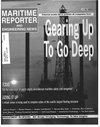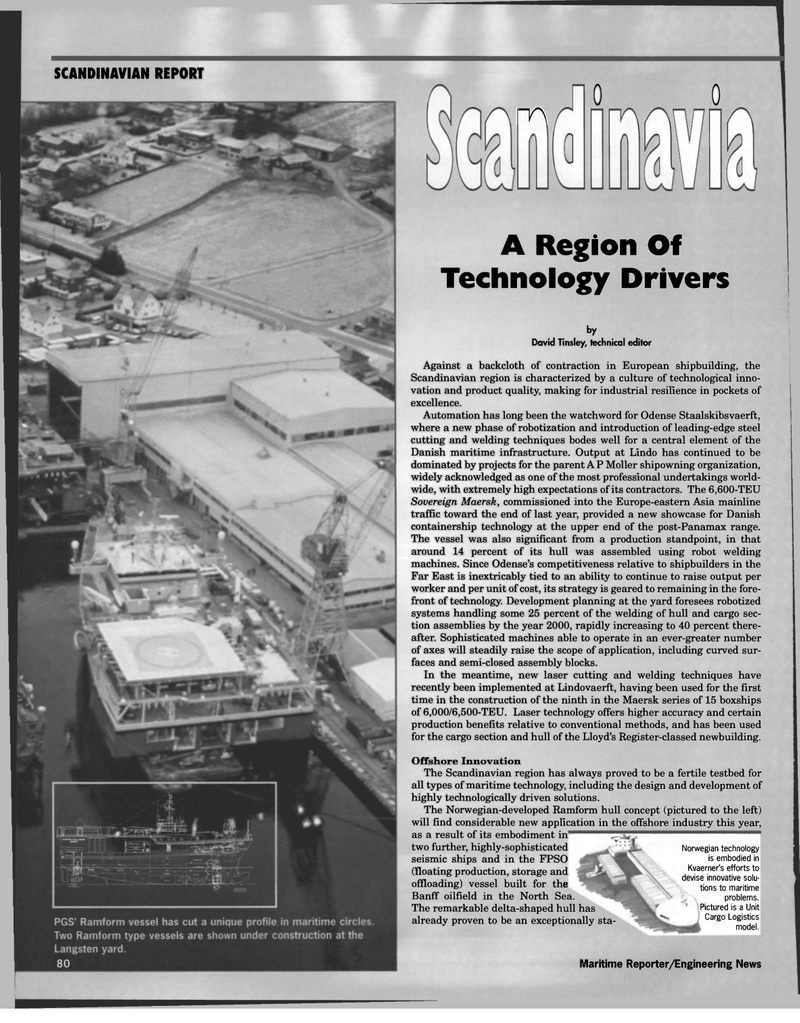
Page 88: of Maritime Reporter Magazine (April 1998)
Read this page in Pdf, Flash or Html5 edition of April 1998 Maritime Reporter Magazine
SCANDINAVIAN REPORT m 0 0
A Region Of
Technology Drivers by
David Tinsley, technical editor
Against a backcloth of contraction in European shipbuilding, the
Scandinavian region is characterized by a culture of technological inno- vation and product quality, making for industrial resilience in pockets of excellence.
Automation has long been the watchword for Odense Staalskibsvaerft, where a new phase of robotization and introduction of leading-edge steel cutting and welding techniques bodes well for a central element of the
Danish maritime infrastructure. Output at Lindo has continued to be dominated by projects for the parent A P Moller shipowning organization, widely acknowledged as one of the most professional undertakings world- wide, with extremely high expectations of its contractors. The 6,600-TEU
Sovereign Maersk, commissioned into the Europe-eastern Asia mainline traffic toward the end of last year, provided a new showcase for Danish containership technology at the upper end of the post-Panamax range.
The vessel was also significant from a production standpoint, in that around 14 percent of its hull was assembled using robot welding machines. Since Odense's competitiveness relative to shipbuilders in the
Far East is inextricably tied to an ability to continue to raise output per worker and per unit of cost, its strategy is geared to remaining in the fore- front of technology. Development planning at the yard foresees robotized systems handling some 25 percent of the welding of hull and cargo sec- tion assemblies by the year 2000, rapidly increasing to 40 percent there- after. Sophisticated machines able to operate in an ever-greater number of axes will steadily raise the scope of application, including curved sur- faces and semi-closed assembly blocks.
In the meantime, new laser cutting and welding techniques have recently been implemented at Lindovaerft, having been used for the first time in the construction of the ninth in the Maersk series of 15 boxships of 6,000/6,500-TEU. Laser technology offers higher accuracy and certain production benefits relative to conventional methods, and has been used for the cargo section and hull of the Lloyd's Register-classed newbuilding.
Offshore Innovation
The Scandinavian region has always proved to be a fertile testbed for all types of maritime technology, including the design and development of highly technologically driven solutions.
The Norwegian-developed Ramform hull concept (pictured to the left) will find considerable new application in the offshore industry this year, as a result of its embodiment in' two further, highly-sophisticated seismic ships and in the FPSO (floating production, storage and offloading) vessel built for the
Banff oilfield in the North Sea.
The remarkable delta-shaped hull has already proven to be an exceptionally sta-
Norwegian technology is embodied in
Kvaerner's efforts to devise innovative solu- tions to maritime problems.
Pictured is a Unit
Cargo Logistics model. 90 Maritime Reporter/Engineering News

 87
87

 89
89
